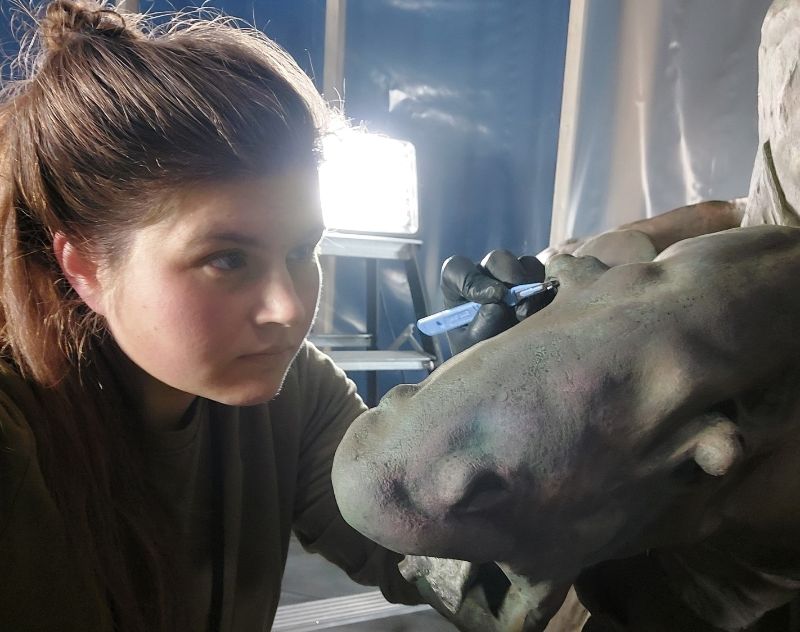Project planner, conservator-restorer
"In general, it is hoped that conservator-restorers would be accurate and diligent at their work and have the ability to concentrate on things in longer term. These are important aspects of my work as well. But working with large objects and being at the mercy of weather conditions in the open air also require tolerance of heights, physical strength and mental perseverance."

- Polina Semenova
- Project planner and conservator-restorer of public art at the public art unit of the Helsinki Art Museum (HAM).
- Graduated with a Bachelor of Culture and Arts (conservator-restorer) degree from Metropolia University of Applied Sciences.
- Eight years of work experience in the field.
Briefly explain what you do for a living.
I take care of preserving public art belonging to the Helsinki art collection. I plan the annual maintenance cycle for the entire art collection, conservation of individual works of art and transfer projects of works. Some of the conservation work I do myself, and some of the work is ordered from external service providers. Close cooperation with other actors in the city, such as the environment division and construction services, plays a key role in my work.
How have you ended up in the profession of your choice?
In a way, by chance, and in a way not. In upper secondary school, I was interested in psychology and social sciences. But after the matriculation examination, I was so exhausted that I could no longer study for the entrance exams. I therefore looked for training courses with entrance examinations that would not require advance preparation. The conservator-restorer training met this criterion. I had some knowledge of the field, as my art teacher's daughter had started her studies in the field a few years earlier. Back then I thought: wow, that's an interesting field. Maybe that's when the idea started to take shape in my mind.
Specialisation in sculptures came through work practice and was purely the idea of my college friend at the time and my current spouse. On the other hand, it didn't come out of the blue, as I remember that sculptures had already attracted me as a child. They were part of the setting for my childhood plays.
Describe your typical working day or week.
A typical working day depends on the season. When the weather is warm, I carry out a lot of condition checks and practical conservation work. During cold weather, my work mainly involves office work, i.e., planning for the coming season, preparing orders and contracts, developing operating methods and collaborating with colleagues. In spring, there are often work placements open at our museum. Then I may participate in guiding conservator-restorer students. I also provide a lot of counselling related to maintaining and conserving public art. In addition, I give expert speeches at various events in the field.
What kind of work environment or working hours do you have?
The work environment varies depending on the work task at hand. Office work is carried out in an office in connection with the Art Museum, where I have my own workstation with an electric desk and a saddle chair. When I work in the field with sculptures, I don't have a coffee room, let alone a toilet. Furthermore, the ergonomics of the working positions leaves much to be desired. My working hours are normal office hours which, according to my preference, are between 7 a.m. and 6 p.m. Rare exceptions to this are acute emergency tasks caused by sudden damage to a work. In the metro track area, the maintenance tasks of works of art are also always carried out at night.
What kind of competence or qualities are required in the profession?
In general, it is hoped that conservator-restorers would be accurate and diligent at their work and have the ability to concentrate on things in longer term. These are important aspects of my work as well. But working with large objects and being at the mercy of weather conditions in the open air also require tolerance of heights, physical strength and mental perseverance. It would be very difficult to do my job if I didn’t have a driving licence or could not use a person lift or different tools.
What is the best thing about your profession?
The best thing is to be able to see works at close range. After all, you cannot always discern all the clever details made by artists from the ground. The work also gives conservator-restorers an access to very special places, such as inside sculptures.
What are the downsides of the profession or what seems challenging?
Working outdoors is physically strenuous and requires very detailed planning to succeed. The forms and requirements of the works are so varied that sometimes you need to adapt your tools and working methods especially for the object you are working on. This may sometimes cause some extra trouble.
What would you tell a person considering the profession of a conservator-restorer?
I recommend that you choose an area of specialisation that suits your personality, which makes it possible for you to stand out in working life. Traditionally, the conservator-restorer’s path to permanent employment goes through a number of short-term jobs. It is also very common that you have to travel to another town because of your job.
How do you see the future of your profession?
In my view, the profession of conservator-restorers has established its position in museums and the cultural environment sector. The recognition of expertise should also be reflected in the wage development, but it seems to be behind labour policy decisions. Of course, the need for conservator-restorers is not decreasing in the future either – quite the opposite.
